Plate Cost Card for Beef Steak
How To Calculate Recipe Cost
The recipe cost breakdowns are a big part of Upkeep Bytes. And while you're non likely to have the exact same nutrient costs as me (prices vary quite a bit from location to location, mean solar day to twenty-four hour period, and even store to store), I think it's helpful to meet how each ingredient can bear on the overall cost of a recipe. So at present I'd like to dive a piddling deeper to show you how I make these calculations, and teach you how to calculate recipe costs yourself. Because fifty-fifty if you do it once, I promise yous'll larn a lot!
Originally posted six-xxx-2013, updated 5-21-2020.
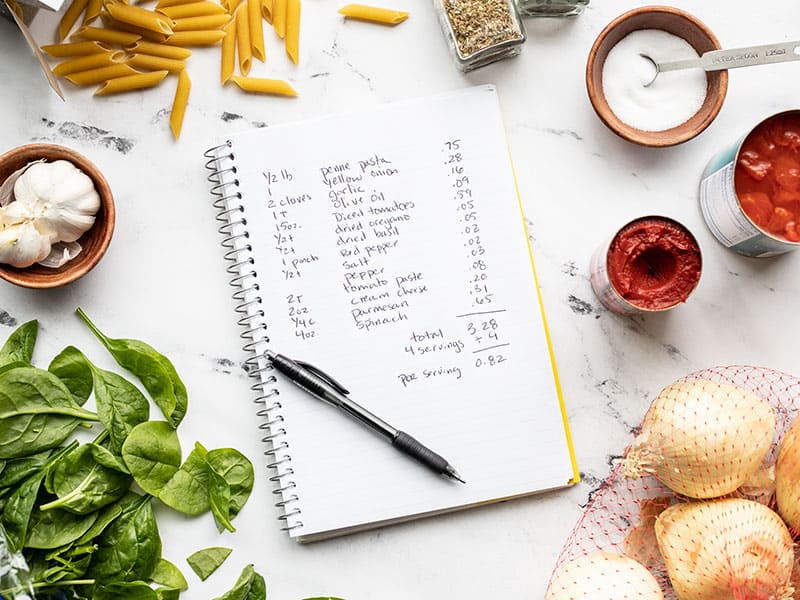
Why Calculate Recipe Costs?
My big "Ah-ha!" moment came when I calculated the cost of my starting time few recipes. I was always very mindful of the total amount I spent at the grocery store every calendar week, just seeing the breakup of each ingredient and the total recipe price that truly revolutionized my manner of cooking.
Seeing this breakup helped me acquire how to tweak recipes to make them more than filling for less money, while maintaining maximum season. I learned that scaling back just a little on the most expensive ingredients (nuts, cheese, meat, etc.) dramatically reduced recipe costs, but didn't have a huge impact on flavor. Likewise, I learned which inexpensive ingredients helped give my nutrient a big season kick for pennies (green onions, cilantro, freshly cracked pepper, dried herbs, etc.), and which ingredients I could utilize to bulk up a recipe without greatly increasing the full cost (rice, pasta, beans, lentils, cabbage, carrots, potatoes, etc.).
What Method Do Y'all Use?
Here on Budget Bytes I utilise the same method of calculating recipe costs used by commercial food service operations—adding the costs of each ingredient used, in the amount used, rather than calculation the full price of items purchased. Some argue that y'all tin't but buy 2 Tbsp of olive oil, so the recipe really costs more than to make. The counter statement to that is that you don't purchase an entire canteen of olive oil every fourth dimension y'all brand a recipe, nor exercise I consider an ingredient "free" if I already have information technology in my kitchen and didn't need to buy it for that recipe. Both methods have their caveats, only I find the method used hither to be the nearly representative of the recipe's true price.
What Practise I Need to Calculate the Cost of a Recipe?
The process is simple and doesn't require a lot of fourth dimension or "equipment." Information technology's so unproblematic, in fact, that I practice this, by hand, forevery single recipe on this website (well over one thousand recipe at this bespeak). To summate recipe costs you'll need:
- Your receipts
- Original ingredient packages
- Pen and paper
- Computer
- Grocery store website (as a fill-in for sourcing prices)
How To Calculate Recipe Costs – Pace past Step Tutorial
Okay, so allow's walk through, footstep past footstep, what I do to summate the cost of a recipe on Budget Bytes. For this tutorial, we'll exist using the Creamy Tomato and Spinach Pasta recipe every bit an instance.
Footstep 1: Write down the recipe ingredients and quantities
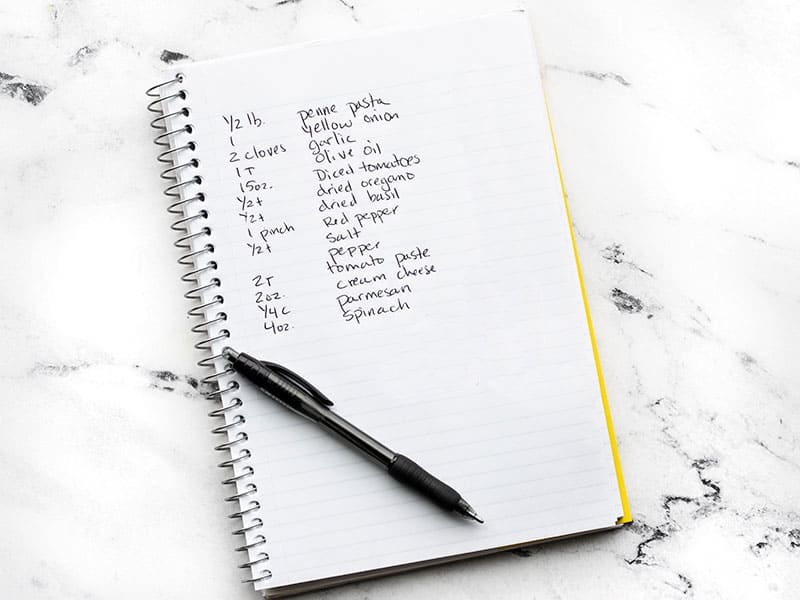
If you like to impress your recipes, you can do the calculations correct on the printed version of the recipe. I always do my calculations in my recipe evolution notebook. Yous'll fill out the prices in the right mitt cavalcade as yous practice the calculations.
Step 2: Fill in prices for ingredients that were used "whole".
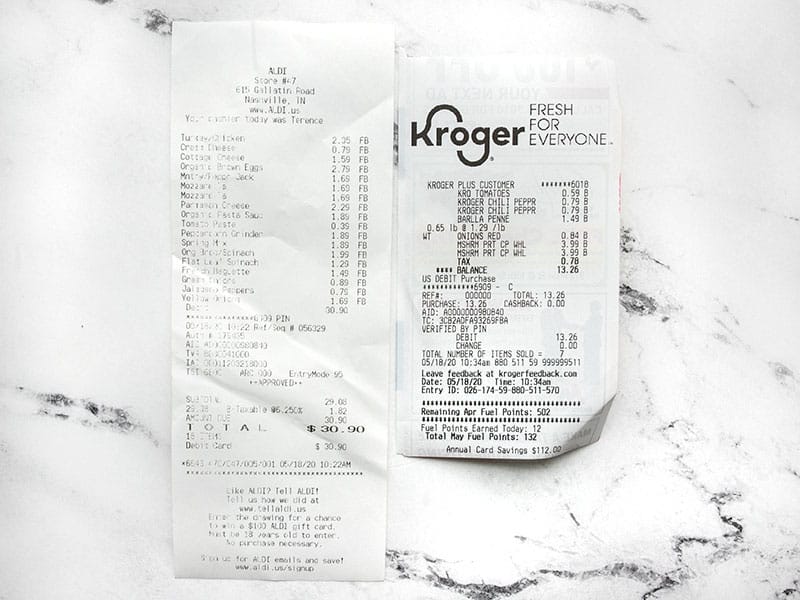
Gather your receipts and record the prices for any ingredient that you used in the "whole" class. This could be ingredients like a can of tomatoes, a cucumber, maybe a jar of pasta sauce, a single bell pepper, etc. In this Creamy Tomato and Spinach Pasta there was only 1 ingredient that I used in the full volume purchased—diced tomatoes. You can see this detail listed as "kro tomatoes $0.59" on the Kroger receipt. Record the toll next to this detail on your recipe ingredient list.
Note: If you don't have your receipts, check your grocery store'south website. Some larger stores, similar Kroger, let yous to look upward items online and the price volition be displayed.
Step 3: Calculate Bulk Produce Items
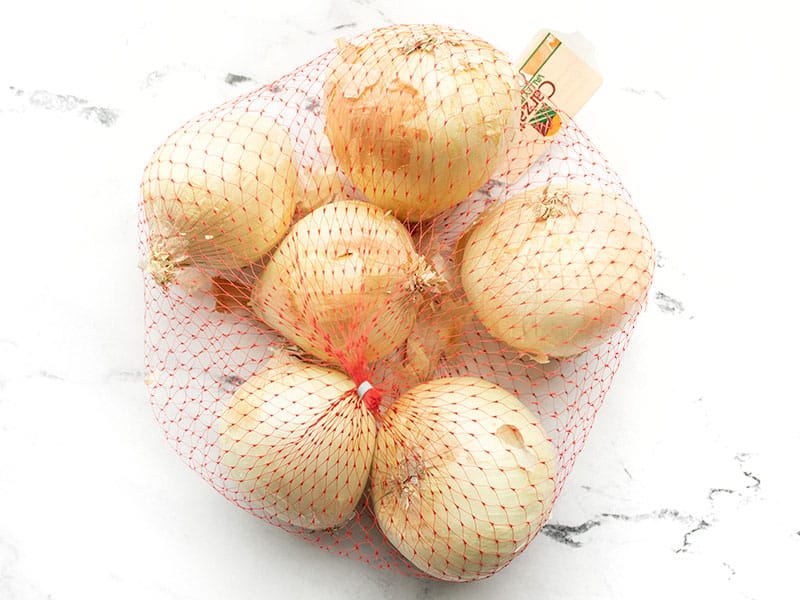
For bulk produce items, take the total price listed on the receipt and separate past the number of items buy. The total price for this bag of yellowish onions listed on the receipt was $1.69 and in that location are six onions in the purse, so each onion is approximately $0.28. Record this toll on your recipe ingredient listing.
This method works adept for other bagged produce, like apples, carrots, oranges, lemons, potatoes, etc. and besides things like packages of chicken thighs or breasts.
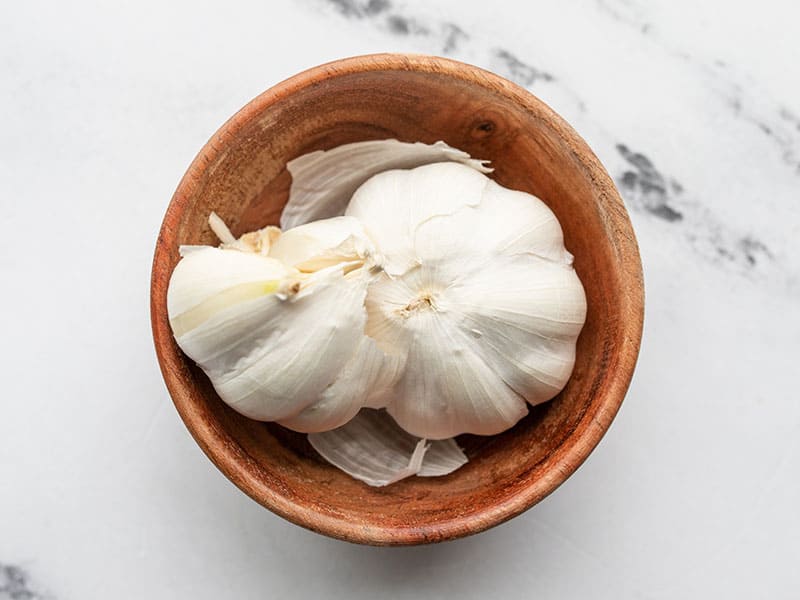
For garlic, each caput is ordinarily around $0.threescore-$0.65 and I get on average about 8 skilful sized cloves from each head, so I but estimate about $0.08 per clove.
Pace 4: Use Package Labels to Summate Partial Ingredient Costs
For well-nigh ingredients you lot'll demand to employ the information listed on the ingredient packages to determine the cost of the amount used in the recipe. Here are some examples:
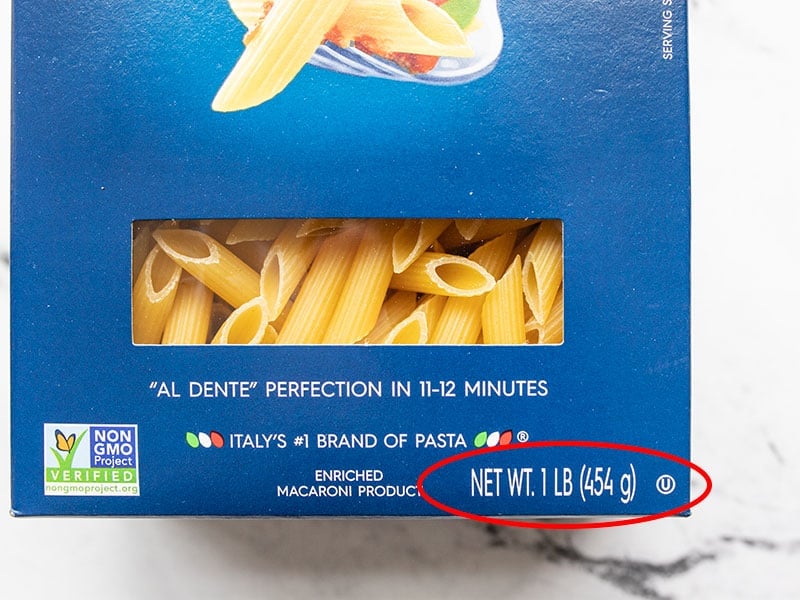
This recipe used one/2 lb. of penne pasta. The whole box (1 lb.) cost $ane.49. Since I used half the box, the cost of the amount used is $1.49 ÷ two = $0.75.
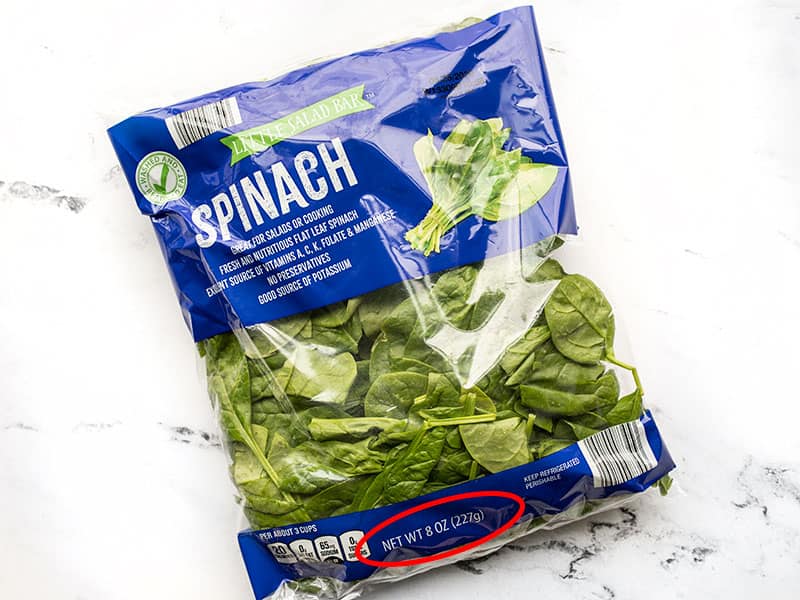
The same method was used for this bag of spinach. The full 8 oz. bag cost $1.29, so the cost of the 4 oz. used is $1.29 ÷ 2 = $0.65.

Sometimes the manufacturers are nice and provide helpful guides for measuring. This total 8 oz. package of cream cheese cost $0.79, so the cost of the 2 oz. used in the recipe is $0.79 ÷ 4 = $0.twenty.
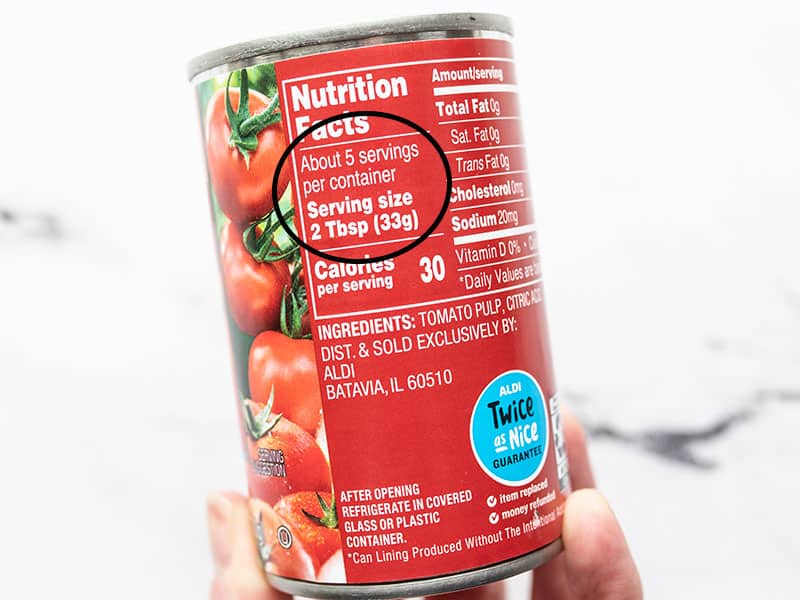
Sometimes the calculations can get a trivial more involved. The cost of this 6 oz. tin of tomato plant paste was $0.39. We can see on the nutrition label that there are v servings of 2 Tbsp in the can, or a total of x Tbsp per tin. We used 2 Tbsp for the recipe, so the cost of what we used is $0.39 ÷ 5 = $0.08.
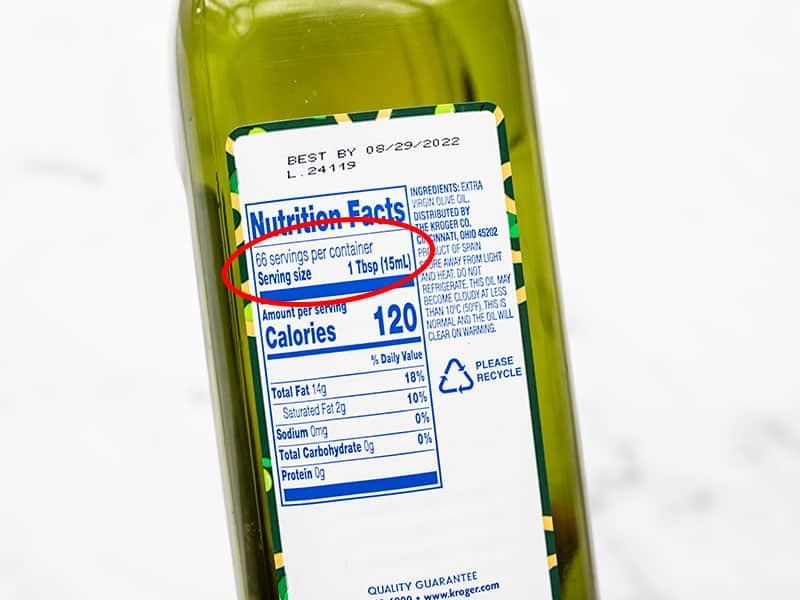
I bought this bottle of olive oil a while back, so I had to refer to Kroger.com to go the price. The total toll for this bottle was $v.95. We can see on the diet label that there are 66 servings of 1 Tbsp in the whole bottle. We used 1 Tbsp for the recipe, so the toll of what we used is $5.95 ÷ 66 = $0.09.
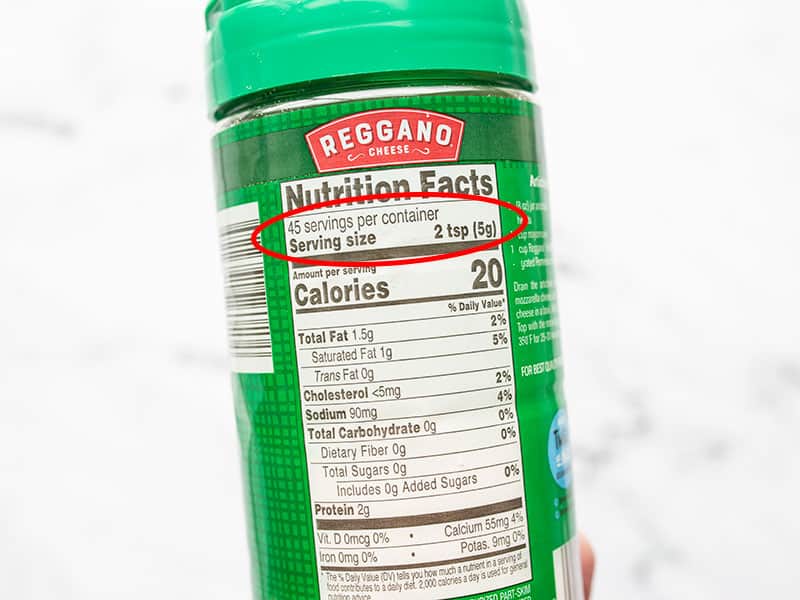
This Parmesan cheese is about as complicated every bit the calculations ordinarily go because nosotros're converting between unit types. We encounter on the characterization that there are 45 servings of ii tsp in the whole canteen. Nosotros used 1/4 cup in the recipe. And so beginning I calculated the price per tsp: $two.29 (total bottle toll) ÷ 45 ÷ two = $0.025 per tsp. I know there are 3 tsp per tablespoon, and 4 tablespoons per 1/iv cup, so I calculated a fiddling further: $0.025 ten 3 x 4 = $0.31 per ¼ cup.
Step five: Gauge Costs for Herbs and Spices
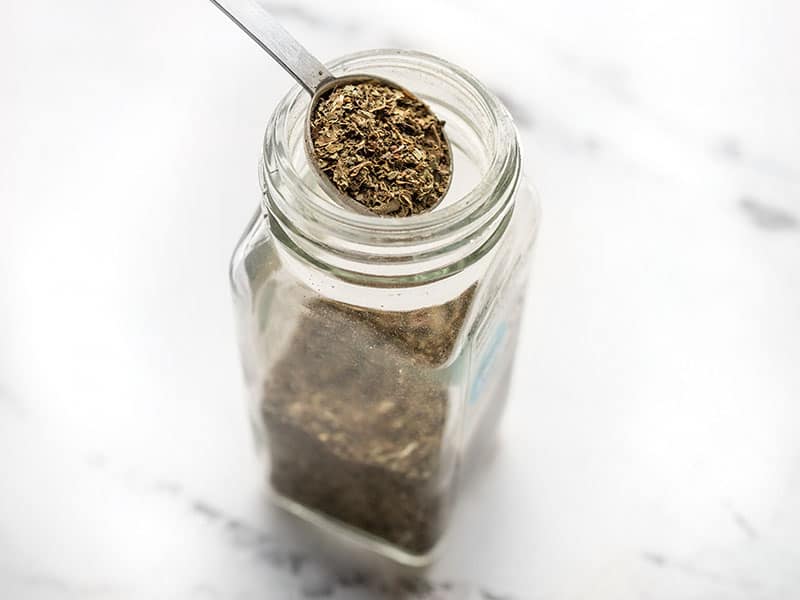
Herbs and spices don't have nutrition labels with serving sizes to work with, and oftentimes the unabridged container only weighs less than 2 oz. Unfortunately I don't have a kitchen scale that is sensitive enough to weigh something as light every bit a 1/ii tsp of a dry out herb. So, for my purposes I use a generic (and generous) allotment of $0.10 per tsp for most dried herbs and spices. For salt and pepper I estimate a little less and for any rare herbs or spices I double the generic estimation. Then, for this recipe: 1/2 tsp stale basil = $0.05, one/2 tsp stale oregano = $0.05, 1 pinch crushed red pepper = $0.02, 1/2 tsp salt = $0.02, freshly cracked pepper = $0.03
Step 4: Add it all together!
And then finally, we accept all of the prices of the ingredients filled in on the recipe ingredient list. At present just just add together them all together and then divide by the number of servings and yous've got the toll per serving. So for this recipe, the total cost was $iii.28 and with four servings that's $3.28 ÷ iv = $0.82 per serving.
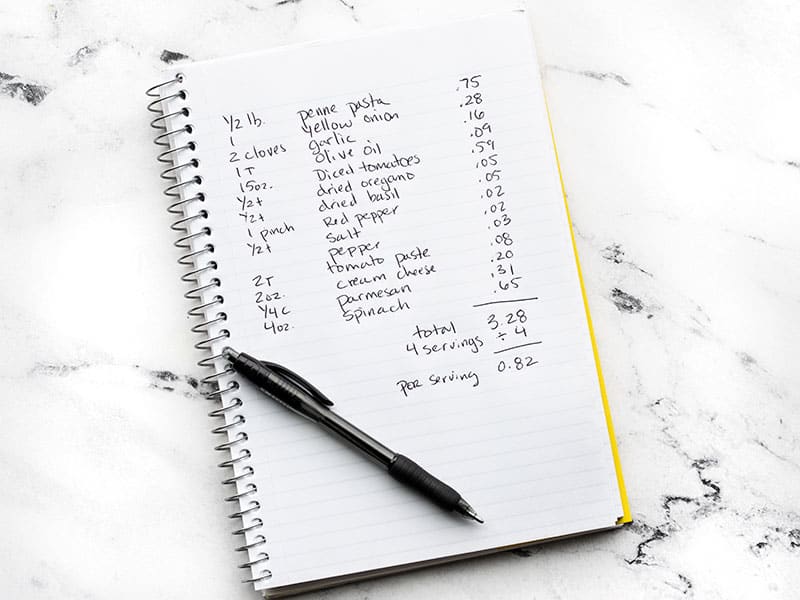
As you can see, it's not an exact science, just it will definitely shed some light on where your money is really going. I promise you try it out at to the lowest degree once just to see how information technology goes. If you want to practise information technology on a regular ground, y'all can start a spreadsheet with price per unit information for your pantry staples. This fashion yous'll take a record of the price for items that you may simply purchase a few times per year (and probably won't have the receipt handy). Luckily, my weblog acts equally a "tape" of these prices, so I can apace refer dorsum to my last purchase price.
What About Electricity, Gas, and H2o?
Every now so I get a question about how utilities add to my recipe costs. Unfortunately I don't have a way to measure the amount and cost of the most of the utilities used in the recipes, but I'm confident that it would be a very pocket-size amount. For instance, in this recipe I used 1/two cup h2o in the sauce. After checking my concluding water bill, I paid $0.003 per gallon of h2o. I round to the nearest cent for these calculations, and then the price of the one/2 cup h2o in this recipe is negligible. Water is easy to measure, but I don't recollect I could mensurate the amount of gas or electricity used to rut the oven.
Handy Conversions for Computing:
- three tsp = ane Tbsp
- iv Tbsp = ane/4 loving cup
- 2 Tbsp = 1 fluid ounce
- 16 Tbsp = 1 loving cup
- 2 fluid ounces = 1/four cup
- 8 fluid ounces = ane cup
- sixteen weight ounces = one pound
NOTE: "fluid ounces" are a volume unit of measurement, weight ounces are a measurement of mass. Solid ingredients are unremarkably listed as weight ounces, liquid ingredients are normally listed in fluid ounces. 8 fluid ounces of one ingredient may non equal 8 weight ounces of that aforementioned ingredient. That will depend on the individual density of the ingredient. Cheese is a great case. 4 oz. (weight) of cheese is equal to most one cup (volume) of shredded cheese. Ane cup is eight fluid ounces in volume, only only 4 weight ounces of shredded cheese.
Attempt It Yourself!
I hope I didn't scare you off with all these calculations! Information technology really is quite simple, especially after you lot practice it a few times. If you're interested in giving information technology a shot, outset with a simple recipe that simply has 3-5 ingredients and meet how you practise! Then, let me know how it worked out in the comments below. :)
P.S. Did you know you tin can scan our recipes past Cost per Recipe and Cost per Serving?
rodriguezwairespleet.blogspot.com
Source: https://www.budgetbytes.com/how-to-calculate-recipe-costs/
0 Response to "Plate Cost Card for Beef Steak"
إرسال تعليق